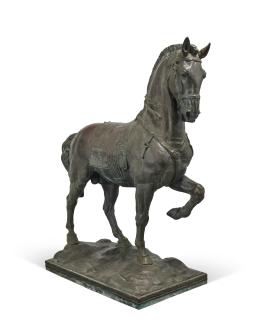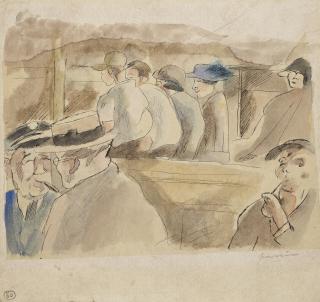- Art.Salon
- Artists
- Émile-Antoine Bourdelle
- Tête d'Apollon, Tête définitive sur grande base

Émile-Antoine Bourdelle
Tête d'Apollon, Tête définitive sur grande base
Found at
Christies,
Paris
La Collection Sam Josefowitz: Vente du jour, Lot 444
21. Oct - 21. Oct 2023
La Collection Sam Josefowitz: Vente du jour, Lot 444
21. Oct - 21. Oct 2023
Estimate: XX.XXX
Price realised: XX.XXX
Price realised: XX.XXX
Description
Bourdelle a passionnément étudié la leçon de l’art grec et sollicité les grandes figures de la mythologie comme une "inépuisable source d’humanité" – Tête d’Apollon (1898-1909), Pénélope (1905-1912), Héraklès archer (1910), Le Centaure mourant (1911-1914), La Méditation d’Apollon et les Muses (1912),… : son œuvre sculpté compte plus d’une quarantaine de sujets antiques. Dieu du soleil qui préside aux jeux des Muses, Apollon inspire poètes et devins. Une inspiration d’autant plus radieuse qu’elle est décochée par la flèche d’or du dieu solaire et guerrier. Modelée vers 1898, abandonnée puis reprise en 1900, la Tête d’Apollon trouve sa forme définitive en 1909. Bourdelle l’a voulue « austère, inquiète, libre de tout passé ». Libre de l’emprise de Rodin et des virtuosités de surface. L’architecture du visage aux arêtes si pures, sur une base presque cubiste, porte la trace des crevasses, craquelures, cicatrices du masque originel que Bourdelle a retravaillé « pour chercher le plan permanent ». Et mener à bien le combat de la création. Quand l’exigence de l’artiste rejoint le précepte du dieu civilisateur, gravé au temple de Delphes : «rien de trop».
Jérôme Godeau (site du Musée Bourdelle)
Bourdelle learnt the lessons of Greek art, and drew on the great mythological figures as an " inexhaustible source of humanity " - Tête d'Apollon (1898-1909), Pénélope (1905-1912), Héraklès archer (1910), Le Centaure mourant (1911-1914), La Méditation d'Apollon et les Muses (1912)... His sculpted work includes over forty subjects inspired by the Antiquity. Apollo was the sun god who presided over the games of the Muses, and inspired poets and soothsayers. This inspiration was all the more radiant for being delivered by the golden arrow of the warrior sun god.
Bourdelle modelled the Tête d'Apollon circa 1898, abandoned it and then went back to ,it in 1900, to complete its final form in 1909. Bourdelle wanted it to be « austere, worried, free of any past". Free from Rodin's influence and superficial virtuosities. The face's structure defined by its very pure edges, stemming from an almost Cubist base, bears the trace of the crevices, cracks and scars of the original mask that Bourdelle reworked "in search of the permanent plane" to win the fight of creation. The artist's demands meet the precept of the civilising god, engraved on the Delphi temple : « nothing too much ».
Jérôme Godeau (Musée Bourdelle website)
- Vente, Mes Bailly-Pommery, Briest et Rieunier, Paris, 19 mars 1996, lot 3. | Collection particulière, Genève (acquis au cours de cette vente). | Puis par descendance aux propriétaires actuels.
Jérôme Godeau (site du Musée Bourdelle)
Bourdelle learnt the lessons of Greek art, and drew on the great mythological figures as an " inexhaustible source of humanity " - Tête d'Apollon (1898-1909), Pénélope (1905-1912), Héraklès archer (1910), Le Centaure mourant (1911-1914), La Méditation d'Apollon et les Muses (1912)... His sculpted work includes over forty subjects inspired by the Antiquity. Apollo was the sun god who presided over the games of the Muses, and inspired poets and soothsayers. This inspiration was all the more radiant for being delivered by the golden arrow of the warrior sun god.
Bourdelle modelled the Tête d'Apollon circa 1898, abandoned it and then went back to ,it in 1900, to complete its final form in 1909. Bourdelle wanted it to be « austere, worried, free of any past". Free from Rodin's influence and superficial virtuosities. The face's structure defined by its very pure edges, stemming from an almost Cubist base, bears the trace of the crevices, cracks and scars of the original mask that Bourdelle reworked "in search of the permanent plane" to win the fight of creation. The artist's demands meet the precept of the civilising god, engraved on the Delphi temple : « nothing too much ».
Jérôme Godeau (Musée Bourdelle website)
- Vente, Mes Bailly-Pommery, Briest et Rieunier, Paris, 19 mars 1996, lot 3. | Collection particulière, Genève (acquis au cours de cette vente). | Puis par descendance aux propriétaires actuels.
Upper estimate price exceeded by 26 %.
The work Tête d'Apollon, Tête définitive sur grande base by Émile-Antoine Bourdelle was sold in the La Collection Sam Josefowitz: Vente du jour auction at Christies in Paris in October this year. It achieved a price of EUR 151,200.00 exceeding the upper end of the estimate range by 26 %. However, buyers have had to dig much deeper into their pockets for other works by Émile-Antoine Bourdelle - we have observed the highest auction result to date for the work Héraklès Archer, Huitième Étude Dite "Modèle Intermédiaire Définitif", which sold at auction in March 2016 for EUR 373,500.00.
Oberer Schätzpreis um 26 % übertroffen
Die Arbeit Tête d'Apollon, Tête définitive sur grande base von Émile-Antoine Bourdelle wurde im Oktober diesen Jahres in der Auktion La Collection Sam Josefowitz: Vente du jour bei Christies in Paris versteigert. Sie erzielte dabei einen Preis von EUR 151.200,00 und übertraf damit das obere Ende der Schätzpreisspanne um 26 %. Für andere Arbeiten von Émile-Antoine Bourdelle mussten die Käufer allerdings auch schon deutlich tiefer in die Tasche greifen – das bisher höchste Auktionsergebnis haben wir für die Arbeit Héraklès Archer, Huitième Étude Dite "Modèle Intermédiaire Définitif" beobachtet, die im März 2016 für EUR 373.500,00 versteigert wurde.









































![Paul Gauguin - Noa Noa, voyage à Tahiti. [Munich, R. Piper, 1926]](/images/paul-gauguin_noa-noa-voyage-a-tahiti-munich-r-piper-1926_AID1174029_320x320.jpg)




